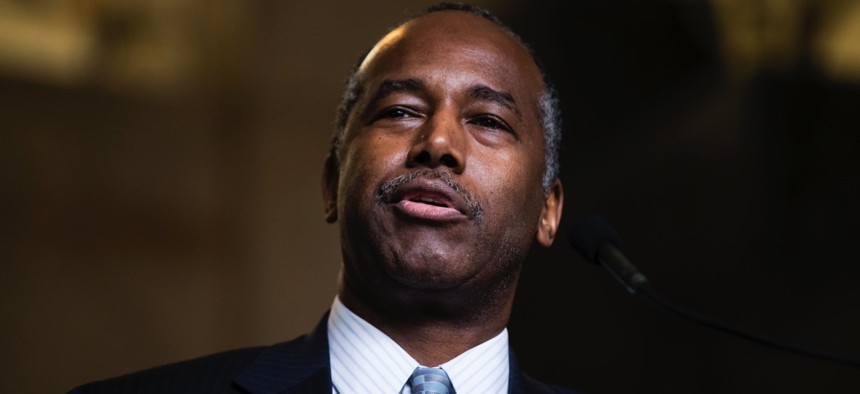Federal Housing Officials Emphasize Local Solutions to Increasing Homelessness

HUD Secretary Ben Carson Matt Rourke / AP Photo
HUD Secretary Ben Carson’s team said communal response needs to be scaled, particularly in major West Coast cities, but without addressing where federal funding fits in.
U.S. homelessness increased 0.7 percent in 2017, driven primarily by a continued lack of affordable housing in major West Coast cities, Housing and Urban Development Secretary Ben Carson said during a conference call with reporters on Wednesday.
Communities of care, or CoCs, pick one day during the last week of January to perform a point-in-time count of clients in their homeless facilities, as well as unsheltered individuals on the streets.
About 4,000 additional homeless persons were counted this year, bringing the total to 553,742, although that number is significantly lower than the approximately 800,000 individuals on the streets 15 years ago, Carson said.
“Increasing homelessness—long waiting lists to get into affordable housing—is not just a federal problem …” Carson said. “It’s a societal problem.”

HUD officials declined to discuss federal budget proposals and funding mechanisms, like Section 8 vouchers, that could ease the local housing crisis, instead emphasizing the importance of communal response and public-private partnerships in spurring future multi-family and mixed-income development.
Cost-effective local solutions like rapid rehousing, especially in the case of homeless families with children, are working and should be scaled depending upon the city, said Matthew Doherty, executive director of the U.S. Interagency Council on Homelessness. Family homelessness declined 5.4 percent in 2017, continuing a 27 percent decline since 2010.
“Limited [housing] supply and skyrocketing rents are impacting our ability to see success in every part of our country,” Doherty said.
The Trump administration has proposed slashing HUD’s $48.7 billion budget by more than $6 billion. Assistant Secretary for Community Planning and Development Neal Rackleff indicated a reactive approach, saying the agency is watching the current tax debate unfold with plans to utilize “every dollar allocated to us as efficiently as possible.”
Most CoCs—60 percent—and 30 states saw declines in total homelessness, but Los Angeles, Seattle, San Diego, Oakland and, on the East Coast, New York City saw significant increases. San Francisco, with the nation’s sixth-largest homeless population, inexplicably remained relatively steady in contrast with the rest of the Bay Area.

California saw the largest uptick in homelessness, at 13.7 percent or 16,136 people, and Georgia the largest decrease, at 21.2 percent or 2,735 people. The Golden State also had the highest rate of unsheltered homeless individuals, 77.8 percent or 87,743 out of 112,756 individuals, compared to Iowa’s low of 6.9 percent or 104 out of 1,500 individuals.

Since 2015, 57 CoCs like Pittsburgh; Kansas City, Missouri; Atlanta; and most recently Delaware County, Pennsylvania have functionally eliminated veterans’ homelessness along with three states. But veterans’ homelessness saw a 1.5 percent increase in 2017—up 585 people.
Youth homelessness increased 14.3 percent to 40,799 people, 55 percent of which are unsheltered. That increase was expected because of increased outreach to the demographic after years of undercounting.
Point-in-time homelessness reporting is a “bit of a blunt instrument,” and stakeholders must “act on local and regional variations within the data,” Doherty said.
Still, HUD officials said its report represented the most complete homelessness data to date, an assertion challenged by the National Law Center on Homelessness and Poverty, which argues the agency’s flawed methodology leads to significant undercounting. The unsheltered in particular tend to be overlooked and counted inconsistently year to year, according to the center.
“Homelessness is a national crisis, and an accurate count of people experiencing it is essential to developing and adopting policies that can truly solve the problem, said Maria Foscarinis, the center’s founder and director, in a statement. “A visual street count does not and cannot capture the number of unsheltered homeless living out of sight, nor does it capture people living in the many outdoor locations that are not even included in the count.”
Dave Nyczepir is a News Editor at Government Executive’s Route Fifty and is based in Washington, D.C.
NEXT STORY: De-energized Power Lines Can’t Spark Wildfires






